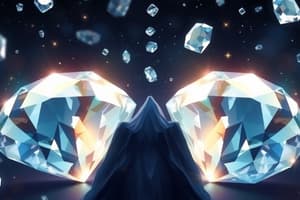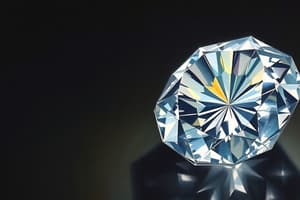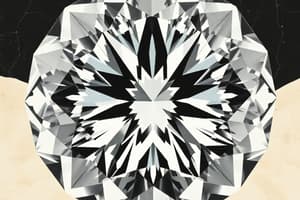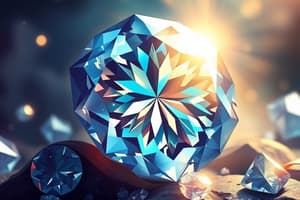Podcast
Questions and Answers
What characteristic does a classic ring with a crown setting typically have?
What characteristic does a classic ring with a crown setting typically have?
- Decorated with multiple gemstones along the band
- Two connection points with a cathedral design
- One connection point and prone to catching (correct)
- Made in one piece with a smooth finish
What is a defining feature of the slim micro pave setting?
What is a defining feature of the slim micro pave setting?
- Each diamond is hand-drilled and set under a microscope (correct)
- It is designed to hold only one stone at a time
- It requires quick mass production techniques
- It uses larger prongs to hold the diamonds
In which type of setting would you find stones sharing prongs?
In which type of setting would you find stones sharing prongs?
- Wall pave setting
- Cathedral setting
- Shared prong setting (correct)
- Floral setting
What is the primary advantage of using the micro pave setting over other production methods?
What is the primary advantage of using the micro pave setting over other production methods?
Which type of setting is considered more antique in style?
Which type of setting is considered more antique in style?
What does the term 'clarity' in diamonds primarily refer to?
What does the term 'clarity' in diamonds primarily refer to?
Which clarity grade indicates a diamond with no inclusions and blemishes visible under any magnification?
Which clarity grade indicates a diamond with no inclusions and blemishes visible under any magnification?
What is considered 'eye clean' in diamond terminology?
What is considered 'eye clean' in diamond terminology?
How are 'Very Slightly Included' diamonds graded?
How are 'Very Slightly Included' diamonds graded?
What typically characterizes a Slightly Included (SI1 or SI2) diamond?
What typically characterizes a Slightly Included (SI1 or SI2) diamond?
What would be considered an 'Included' diamond?
What would be considered an 'Included' diamond?
What type of diamond often gets used in the tool and die industry due to its imperfections?
What type of diamond often gets used in the tool and die industry due to its imperfections?
What could be concluded about the pricing of S&P diamonds?
What could be concluded about the pricing of S&P diamonds?
What does the term 'cut' refer to in relation to diamonds?
What does the term 'cut' refer to in relation to diamonds?
What is meant by an 'internally flawless' diamond?
What is meant by an 'internally flawless' diamond?
How does the thickness of the girdle affect a diamond?
How does the thickness of the girdle affect a diamond?
What happens to a diamond's rating after it has been set and then re-graded?
What happens to a diamond's rating after it has been set and then re-graded?
Which aspect primarily determines a diamond's light performance?
Which aspect primarily determines a diamond's light performance?
What is NOT a confusion that people may have regarding diamond terminology?
What is NOT a confusion that people may have regarding diamond terminology?
What can be true about diamonds that are marketed as flawless?
What can be true about diamonds that are marketed as flawless?
What phenomenon do people sometimes confuse with a blue diamond?
What phenomenon do people sometimes confuse with a blue diamond?
What is one reason companies continue to work with platinum?
What is one reason companies continue to work with platinum?
What is the primary component of rose gold?
What is the primary component of rose gold?
Which karat of yellow gold is known for being the purest?
Which karat of yellow gold is known for being the purest?
What is a common characteristic of a 4-prong setting?
What is a common characteristic of a 4-prong setting?
Which side profile is associated with increased durability?
Which side profile is associated with increased durability?
What characteristic does a stone under 1ct exhibit with a 6-prong setting?
What characteristic does a stone under 1ct exhibit with a 6-prong setting?
What distinguishes the traditional 6-prong setting from the hexagonal setting?
What distinguishes the traditional 6-prong setting from the hexagonal setting?
Which feature is true for rings made of 14k yellow gold?
Which feature is true for rings made of 14k yellow gold?
What is a key characteristic of moissanite in comparison to other gemstones?
What is a key characteristic of moissanite in comparison to other gemstones?
Which type of gold is generally recommended for maintaining both whiteness and durability?
Which type of gold is generally recommended for maintaining both whiteness and durability?
What happens to the appearance of platinum when it is scratched?
What happens to the appearance of platinum when it is scratched?
Which statement accurately describes white gold?
Which statement accurately describes white gold?
What is a disadvantage of using white gold for jewelry in terms of wear?
What is a disadvantage of using white gold for jewelry in terms of wear?
Why is platinum considered a hypoallergenic option?
Why is platinum considered a hypoallergenic option?
What can be a visible effect of platinum's patina over time?
What can be a visible effect of platinum's patina over time?
What is the primary reason for choosing white gold over silver for fine jewelry?
What is the primary reason for choosing white gold over silver for fine jewelry?
What effect does strong fluorescence have on a diamond in daylight?
What effect does strong fluorescence have on a diamond in daylight?
Which cut of diamond is known for being very transparent and having understated sparkle?
Which cut of diamond is known for being very transparent and having understated sparkle?
How does the number of facets in the Old Mine Cut compare to the Modern Cut?
How does the number of facets in the Old Mine Cut compare to the Modern Cut?
Which category does the Radiant Cut fall into?
Which category does the Radiant Cut fall into?
What is the characteristic of the Modern Round Brilliant cut?
What is the characteristic of the Modern Round Brilliant cut?
What happens when a stone has a ratio greater than 1.5?
What happens when a stone has a ratio greater than 1.5?
Which diamond type is referred to as having a 'fresh ice' look?
Which diamond type is referred to as having a 'fresh ice' look?
What kind of diamonds exist under both lab-grown and earth-mined categories?
What kind of diamonds exist under both lab-grown and earth-mined categories?
What factor can cause the price of a diamond to decrease?
What factor can cause the price of a diamond to decrease?
Which diamond cut is often associated with asymmetry?
Which diamond cut is often associated with asymmetry?
Flashcards
S&P Diamonds
S&P Diamonds
Diamonds with imperfections or inclusions, like mineral fragments or other materials. They are often used for industrial purposes like drill bits or files.
Inclusions
Inclusions
Internal characteristics within a diamond, such as carbon deposits, feathers (cracks), and crystal deposits.
Clarity
Clarity
Refers to the presence or absence of internal characteristics (inclusions) and external blemishes within a diamond.
Flawless
Flawless
Signup and view all the flashcards
Internally Flawless
Internally Flawless
Signup and view all the flashcards
Very Very Slightly Included (VVS)
Very Very Slightly Included (VVS)
Signup and view all the flashcards
Very Slightly Included (VS)
Very Slightly Included (VS)
Signup and view all the flashcards
Eye Clean
Eye Clean
Signup and view all the flashcards
Flawless Diamond
Flawless Diamond
Signup and view all the flashcards
Internally Flawless Diamond
Internally Flawless Diamond
Signup and view all the flashcards
Diamond Cut
Diamond Cut
Signup and view all the flashcards
Diamond Shape
Diamond Shape
Signup and view all the flashcards
Diamond Table
Diamond Table
Signup and view all the flashcards
Diamond Girdle
Diamond Girdle
Signup and view all the flashcards
Diamond Culet
Diamond Culet
Signup and view all the flashcards
Diamond Fire
Diamond Fire
Signup and view all the flashcards
Why use Platinum?
Why use Platinum?
Signup and view all the flashcards
Rose Gold Composition
Rose Gold Composition
Signup and view all the flashcards
Rose Gold Karat Limit
Rose Gold Karat Limit
Signup and view all the flashcards
Yellow Gold Karat
Yellow Gold Karat
Signup and view all the flashcards
4 Prong Setting
4 Prong Setting
Signup and view all the flashcards
6 Prong Setting
6 Prong Setting
Signup and view all the flashcards
NSEW/Compass Setting
NSEW/Compass Setting
Signup and view all the flashcards
Cathedral Setting
Cathedral Setting
Signup and view all the flashcards
Moissanite Cut
Moissanite Cut
Signup and view all the flashcards
White vs. Yellow Gold
White vs. Yellow Gold
Signup and view all the flashcards
Choosing a Gold Karat
Choosing a Gold Karat
Signup and view all the flashcards
Rhodium Plating
Rhodium Plating
Signup and view all the flashcards
Platinum's Advantages
Platinum's Advantages
Signup and view all the flashcards
Platinum's Drawbacks
Platinum's Drawbacks
Signup and view all the flashcards
Wear and Tear on Rings
Wear and Tear on Rings
Signup and view all the flashcards
Choosing Platinum or White Gold
Choosing Platinum or White Gold
Signup and view all the flashcards
Classic One Connection Setting
Classic One Connection Setting
Signup and view all the flashcards
Trellis Setting
Trellis Setting
Signup and view all the flashcards
Pave Setting
Pave Setting
Signup and view all the flashcards
Shared Prong Setting
Shared Prong Setting
Signup and view all the flashcards
Diamond Fluorescence
Diamond Fluorescence
Signup and view all the flashcards
Rose Cut
Rose Cut
Signup and view all the flashcards
Old Mine Cut
Old Mine Cut
Signup and view all the flashcards
Old European Cut
Old European Cut
Signup and view all the flashcards
Modern Round Brilliant Cut
Modern Round Brilliant Cut
Signup and view all the flashcards
Brilliant Cut
Brilliant Cut
Signup and view all the flashcards
Step Cut
Step Cut
Signup and view all the flashcards
Radiant Cut
Radiant Cut
Signup and view all the flashcards
Lab-Grown Diamonds
Lab-Grown Diamonds
Signup and view all the flashcards
Moissanite
Moissanite
Signup and view all the flashcards
Study Notes
Diamond Education
- Carat:
- 1 carat equals 200 milligrams
- Different diamond shapes can appear different sizes for the same carat weight
- Princess cut diamonds have most weight in the center, which makes them appear smaller
- Sapphire is heavier than a diamond.
- Size is an important factor for lifestyle considerations, especially for those with more active lifestyles.
- Average diamond size desired is now 2 carats, down from the 20,000+ dollar price range to the 6,000+ dollar price range.
Diamond Color
- A color grading system was created in the early 1900s to standardize grading, using the letters D through Z to identify colors.
- D-F are considered colorless.
- G-J are considered near colorless.
- K-M are considered faint.
- N-R are considered very light.
- S-Z are considered light colored.
- Colorless through light colors are what are typically worked with most.
Diamond Clarity
- Clarity refers to internal characteristics like inclusions, which can include Carbon deposits, feathers (looking like cracks), and crystal deposits.
- Flawless (no visible inclusions, no blemishes)
- Internally flawless (no visible inclusions, but may have blemishes)
- Very very Slightly Included: VVS1, VS2 (inclusions difficult for trained graders to see)
- Very Slightly Included: VS1, VS2 (inclusions require some magnification to see)
- Slightly Included (SI): SI1, SI2 (inclusions will be noticeable)
Diamond Cut
- Cut refers to the facets and the way light reflects off the diamond.
- Cut quality affects sparkle (fire and scintillation).
- Ideal, deep, and shallow cut diamonds are possible results.
- Shape and how light reflects affect different looks and symmetry.
- Excellent and Very Good are ideal cuts, while Poor and Fair may not reflect light correctly.
### Diamond Fluorescence
- Fluorescence is a natural effect of some diamonds.
- When exposed to black light it can make some diamonds appear cloudy in daylight.
- This can slightly detract from the price of the diamond.
Diamond Certificates
- Certificates are created by labs to ensure authenticity in grading.
- The grading is done by an independent third party lab so there's no conflict of interest.
- GIA is the most common body involved.
- Canadian origin diamond labels cost extra to include.
- Smaller stones are often sold in groups
Gemstone Video #2
- Sapphires, emeralds, and rubies aren't typically given certificates because those types of gems are already determined by specific origins and qualities.
- Gemstones can be traced back to where and how they were mined.
- Gemstones are typically described using terms that are clear and understandable (rather than overly technical).
- "Inclusions", visible imperfections, are normal in non-diamond gemstones.
Studying That Suits You
Use AI to generate personalized quizzes and flashcards to suit your learning preferences.




